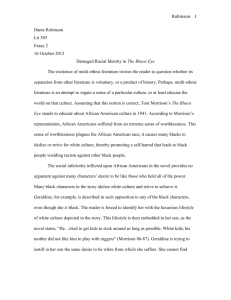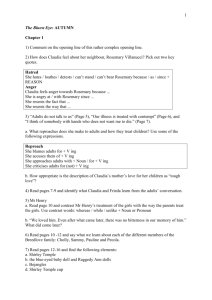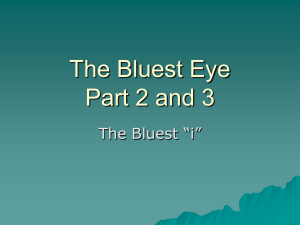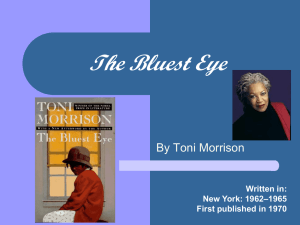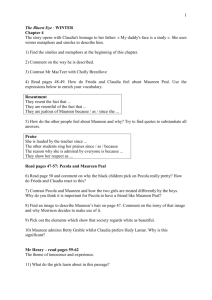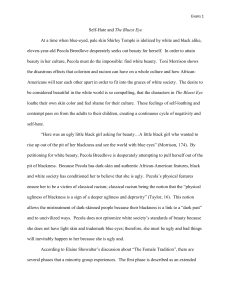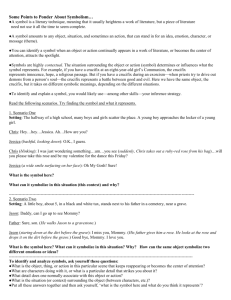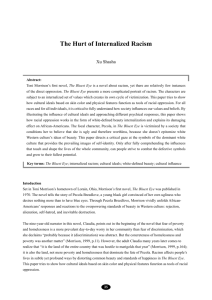The Lack of Beauty and Identity in the Bluest Eye by Toni Morrison
advertisement
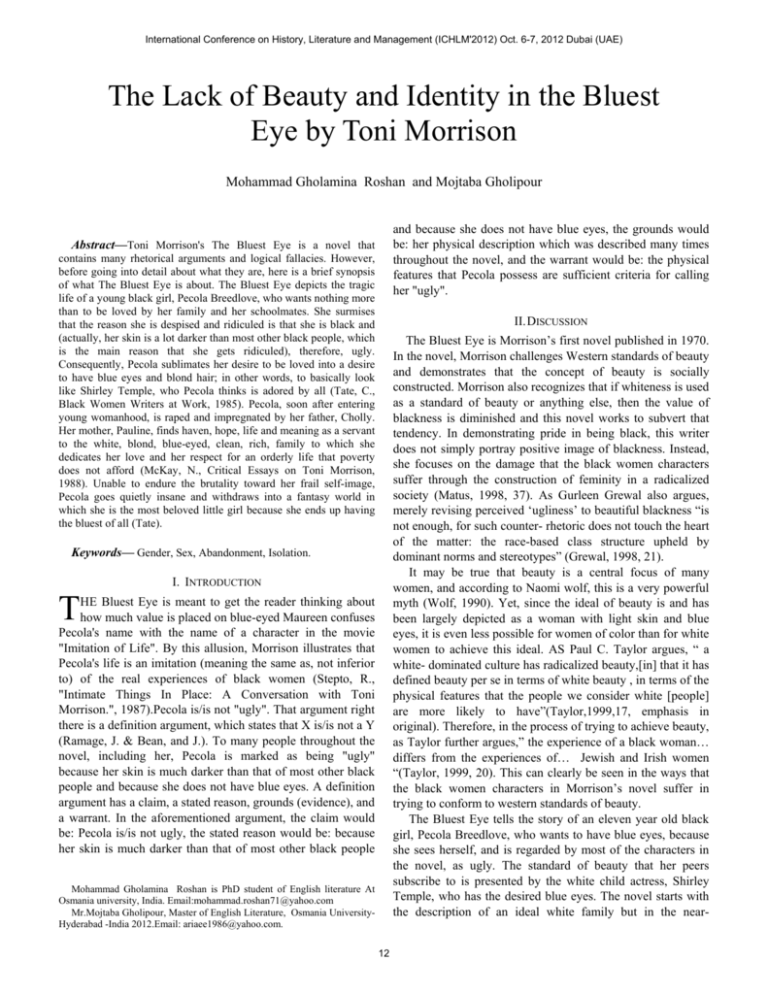
International Conference on History, Literature and Management (ICHLM'2012) Oct. 6-7, 2012 Dubai (UAE) The Lack of Beauty and Identity in the Bluest Eye by Toni Morrison Mohammad Gholamina Roshan and Mojtaba Gholipour and because she does not have blue eyes, the grounds would be: her physical description which was described many times throughout the novel, and the warrant would be: the physical features that Pecola possess are sufficient criteria for calling her "ugly". Abstract—Toni Morrison's The Bluest Eye is a novel that contains many rhetorical arguments and logical fallacies. However, before going into detail about what they are, here is a brief synopsis of what The Bluest Eye is about. The Bluest Eye depicts the tragic life of a young black girl, Pecola Breedlove, who wants nothing more than to be loved by her family and her schoolmates. She surmises that the reason she is despised and ridiculed is that she is black and (actually, her skin is a lot darker than most other black people, which is the main reason that she gets ridiculed), therefore, ugly. Consequently, Pecola sublimates her desire to be loved into a desire to have blue eyes and blond hair; in other words, to basically look like Shirley Temple, who Pecola thinks is adored by all (Tate, C., Black Women Writers at Work, 1985). Pecola, soon after entering young womanhood, is raped and impregnated by her father, Cholly. Her mother, Pauline, finds haven, hope, life and meaning as a servant to the white, blond, blue-eyed, clean, rich, family to which she dedicates her love and her respect for an orderly life that poverty does not afford (McKay, N., Critical Essays on Toni Morrison, 1988). Unable to endure the brutality toward her frail self-image, Pecola goes quietly insane and withdraws into a fantasy world in which she is the most beloved little girl because she ends up having the bluest of all (Tate). II. DISCUSSION The Bluest Eye is Morrison’s first novel published in 1970. In the novel, Morrison challenges Western standards of beauty and demonstrates that the concept of beauty is socially constructed. Morrison also recognizes that if whiteness is used as a standard of beauty or anything else, then the value of blackness is diminished and this novel works to subvert that tendency. In demonstrating pride in being black, this writer does not simply portray positive image of blackness. Instead, she focuses on the damage that the black women characters suffer through the construction of feminity in a radicalized society (Matus, 1998, 37). As Gurleen Grewal also argues, merely revising perceived ‘ugliness’ to beautiful blackness “is not enough, for such counter- rhetoric does not touch the heart of the matter: the race-based class structure upheld by dominant norms and stereotypes” (Grewal, 1998, 21). It may be true that beauty is a central focus of many women, and according to Naomi wolf, this is a very powerful myth (Wolf, 1990). Yet, since the ideal of beauty is and has been largely depicted as a woman with light skin and blue eyes, it is even less possible for women of color than for white women to achieve this ideal. AS Paul C. Taylor argues, “ a white- dominated culture has radicalized beauty,[in] that it has defined beauty per se in terms of white beauty , in terms of the physical features that the people we consider white [people] are more likely to have”(Taylor,1999,17, emphasis in original). Therefore, in the process of trying to achieve beauty, as Taylor further argues,” the experience of a black woman… differs from the experiences of… Jewish and Irish women “(Taylor, 1999, 20). This can clearly be seen in the ways that the black women characters in Morrison’s novel suffer in trying to conform to western standards of beauty. The Bluest Eye tells the story of an eleven year old black girl, Pecola Breedlove, who wants to have blue eyes, because she sees herself, and is regarded by most of the characters in the novel, as ugly. The standard of beauty that her peers subscribe to is presented by the white child actress, Shirley Temple, who has the desired blue eyes. The novel starts with the description of an ideal white family but in the near- Keywords— Gender, Sex, Abandonment, Isolation. I. INTRODUCTION T HE Bluest Eye is meant to get the reader thinking about how much value is placed on blue-eyed Maureen confuses Pecola's name with the name of a character in the movie "Imitation of Life". By this allusion, Morrison illustrates that Pecola's life is an imitation (meaning the same as, not inferior to) of the real experiences of black women (Stepto, R., "Intimate Things In Place: A Conversation with Toni Morrison.", 1987).Pecola is/is not "ugly". That argument right there is a definition argument, which states that X is/is not a Y (Ramage, J. & Bean, and J.). To many people throughout the novel, including her, Pecola is marked as being "ugly" because her skin is much darker than that of most other black people and because she does not have blue eyes. A definition argument has a claim, a stated reason, grounds (evidence), and a warrant. In the aforementioned argument, the claim would be: Pecola is/is not ugly, the stated reason would be: because her skin is much darker than that of most other black people Mohammad Gholamina Roshan is PhD student of English literature At Osmania university, India. Email:mohammad.roshan71@yahoo.com Mr.Mojtaba Gholipour, Master of English Literature, Osmania UniversityHyderabad -India 2012.Email: ariaee1986@yahoo.com. 12 International Conference on History, Literature and Management (ICHLM'2012) Oct. 6-7, 2012 Dubai (UAE) periodic style of a school reading primer, where we meet Dick and Jane text functions as “the hegemonizing force of an ideology([focused by] the supremacy of ‘the bluest eye’) by which a dominant culture reproduces[its] hierarchical power structure[s]”(Grewal, 1998, 24.As Donald B. Gibson also argues, the Dick and Jane text implies one of the primary and most insidious ways that the dominant culture exercises its hegemony, through the educational system. It reveals the role of education in both oppressing the victim- and more to the point- teaching the victim how to oppress her own black self by internalizing the values that dictate standards of beauty (Gibson,1989, 20). In contrast to his hegemonic identity, the main black characters are depicted as various and very different characters located in three hierarchical families: first Geraldine’s (a counterfeit of the idealized white family)… [then] the MacTeersand at the bottom [of the social order]’ the Breedloves” (Ogunyemi, 19977, 113) the novel shows how these black characters respond to the dominant culture differently and this refuse easy binary social distinctions. Pauline Breedlove, Geraldine, Maureen peal, and Pecola are black characters who try to conform to an imposed ideal of feminity. They are absorbed and marginalized by the “cultural icons portraying physical beauty: movies, billboards, magazines, books, newspapers, window signs, dolls, and drinking cups” (Gibson, 1989, 20). Pauline Breedlove, for example, learns about physical beauty from the movies. Concept of identity, for these varying dynamics could not exist without the varying identities of each of the characters. The first obvious appearance of social identity in The Bluest Eye comes with the example of pecola, who prefers above all other containers to drink out of her Shirley Temple cup. The reason for her preference lies in Shirley’s blue eyes. Pecola throughout her life knew that she was ugly, her father, mother, and brother were all ugly and so was she. As a result, pecola looked upon Shirley and her blues eyes, worthy of being placed on her cup, as an icon of beauty. Her image, placed upon a cup and all over the silver screen, was something the out-group and dominant culture in pecola’s life had idolized. True beauty, Shirley’s beauty, was something no black girl could ever aspire achieve. The second source of pecola’s ugliness comes from stimuli received from members of the out-group actually in her life, namely Mr. Yacobowski.In a poignant scene, pecola, decides to purchase candy from Mr. Yacobowski’s grocery store. As she offers up the change to pay for her candy, he looks down at her distance, or in Morrison’s description:“She looks up at him and sees the vacuum where curiosity ought to lodge. And something more. The total absence of human recognition the glazed separateness. She does not know what keeps his glance suspended… The distaste must be for her, her blackness. (Morrison, p.48-49).As the scene progress, Morrison describes how Mr. Jacobowski scrapes the change out of her hand in an attempt to limit his actual physical contact with her.Pecola’s personal out-group, (the group capable of having blue eyes) had not only rejected her due to her blackness, but rejected her humanity. Mr. Jacobowski’s treatment is a result of the white ethnocentrism present in the 1950’s which as Hewstone and Cairns explain is “defined as the view of things in which one’s own group is the center of everything, and all others are scaled or rated with reference to it” (Cairns, Ed and Miles Hewstone.pg.32) Mr. Jacobowski’s ethno centrist outlook on Pecola readily displayed to her that she was rated as less than the out-group in her life. Once again, Pecola’s world showed her how ugly she was. Pecola’s identity in society had yet another source of negativity, which originated from those of her own race that looked down upon poorer, less fortunate black. This was a new kind of hate, a hate that she had not experienced from members of her own race, which was class hatred. In this scene of the book Pecola is lured into the home of a boy named Junior. His mother, Geraldine, has throughout his life offered more love to the family’s blue eyed, black cat than to him. Junior uses this opportunity to kill his mother’s cat and blame it on Pecola. When Geraldine arrives home to see what has happened, she become angry and tells her, “Get out you nasty little black bitch.” (Morrison, Toni. Pg 91) Earlier in the story Geraldine had explained to Junior the difference between “colored people and niggers.” The class/racial identity introduced in this part of the novel display one of the many consequences of white racism. Geraldine lived her life in an upper class world (i.e. as upper class as black could achieve at that time). However het stature as a decent or “colored” person, in the eyes of her white, middle class peers was constantly threatened by what she saw in her mind as poorly kept, and poorly mannered “niggers”. The positive identity that Geraldine had made for herself was one that placed her above less fortunate members of her race. For this reason, she lashed out at Pecola, simply because of her disheveled appearance and Junior’s accusation.Hewstone and Cairns offer a good explanation for Geraldine’s behavior in their explanation of Henri Tajfel’s writings. According to Tajfel’s reasoning group behavior typically fits into three major characteristics: “First, at least two clearly identifiable social categories must be present in the situation…Second; there should be little variability of behavior or attitude within each group…Third, a member of the other group.” (Cairns, Ed and Miles Hewstone. Pg 324) While the first criterion does not lend itself well to this example, the latter criteria (particularly the third) explain Geraldine’s reaction to Pecola. She was not only black like Pecola, but Pecola was in her house, which was a threat to her identity. In order for Geraldine to truly feel like she was on par with her white middle class counter parts, she had to have a quaint, well kept house. This was yet another formative event for Pecola’s negative identity of herself. Junior, a member of what she clearly thought was part of her in-group (or she would not have trusted him), had betrayed her. This, coupled with Geraldine’s harsh words, in a matter of moments catapulted Pecola from the false security of what she thought was her in-group, into 13 International Conference on History, Literature and Management (ICHLM'2012) Oct. 6-7, 2012 Dubai (UAE) [10] S. P. Bingulac, “On the compatibility of adaptive controllers (Published Conference Proceedings style),” in Proc. 4th Annu. Allerton Conf. Circuits and Systems Theory, New York, 1994, pp. 8–16. [11] G. R. Faulhaber, “Design of service systems with priority reservation,” in Conf. Rec. 1995 IEEE Int. Conf. Communications, pp. 3–8. [12] W. D. Doyle, “Magnetization reversal in films with biaxial anisotropy,” in 1987 Proc. INTERMAG Conf., pp. 2.2-1–2.2-6. the world of the other. Nearly every experience mentioned by Morrison in Pecola’s life (while she was still sane) reinforced the concept that she was ugly and undesired. Any chance of having a positive identity and self esteem throughout her life was dashed to pieces by acts of hate committed by members of the out-group in her life, and the groups to which she actually belonged. These events were piled on top of the poor identity she had received from her unfortunate family situation, along with her own personal belief that she was ugly. These factors readily show why Pecola so readily identified with the Maginot Line, China, and Poland. They treated her like any other little girl. When she was with them she was not ugly, she was not poor and unmannered, and she was not black, she was just a little girl. The apartment above her own where the prostitutes lived was the only lace it seems that Pecola could go without wishing she was something or someone else. . III. CONCLUSION Morrison aptly displays how social identities are formed and replicated in a person’s life. The example of pecola, while rather extreme in many cases, show the extent to which occurrence of rejection can be heavily formative. Furthermore, the story of pecola creates and excellent framework for understanding how difficult the fight for a positive social identity and self esteem. Perhaps the most intriguing facet of pecola’s search identity is the enormous scope and power of unhindered racism. White racism had caused members of pecola’s own in group to hate each other. In conclusion, the social identities in place in The Bluest eye provide excellent examples of how social identities are created and then replicated. Furthermore, the novel renders hard evidence of how hard social and group identities are to break. Morrison’s writings are truly an exemplary display of the difficulties involved in obtaining a positive social identity. REFERENCES [1] [2] [3] [4] [5] [6] [7] [8] [9] Carins, Ed and Miles Hewstone.”Social psychology and intergroup conflict.pg.324 Gibson, Donald B. (1989), “Text and Counter text in Toni Morrison’s The Bluest Eye”, Lit: Literature, Interpretation, Theory, Vol. 1 No. 1-2, pp. 19-32. Grewal, Gurleen (1998), Circles of sorrow, Lines of struggle: The novels of Toni Morrison, Boston, Louisiana State University press. Morrison Toni (1970, 1999), the Bluest Eye, Vintage. Ogunyemi, Chikwenye (1977), “Order and Disorder in Toni Morrison’s The Bluest Eye”, Critique: studies in Modern fiction, Vol. 19, pp. 11212o. Taylor, Paul C.(1999),”Malcolm’s Conk and Danto’s Colors; or four Logical petitions Concerning Race, Beauty, and Aesthetics”, The journal of Aesthetics and art Criticism, Vol. 57,No.1,pp.16-20. J. U. Duncombe, “Infrared navigation—Part I: An assessment of feasibility (Periodical style),” IEEE Trans. Electron Devices, vol. ED11, pp. 34–39, Jan. 1959. S. Chen, B. Mulgrew, and P. M. Grant, “A clustering technique for digital communications channel equalization using radial basis function networks,” IEEE Trans. Neural Networks, vol. 4, pp. 570–578, July 1993. R. W. Lucky, “Automatic equalization for digital communication,” Bell Syst. Tech. J., vol. 44, no. 4, pp. 547–588, Apr. 1965. 14
